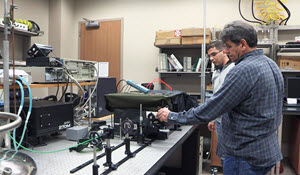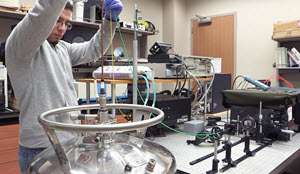
Bassam Alfarhani aligns the laser beam of the multidimensional luminescence system. (Provided by Andres Campiglia)
Polycyclic aromatic hydrocarbons with high molecular weights (HMW-PAHs) are potentially toxic compounds that can cause genetic mutations. However, current environmental monitoring and analyses of human health risks only focus on the sixteen PAHs that the Environmental Protection Agency considers priority pollutants.
The Gulf of Mexico Research Initiative awarded Dr. Andres D. Campiglia a grant to expand environmental monitoring efforts to include higher weight PAHs. These PAHs are difficult to quantify because they appear in lower concentrations than priority PAHs and the analytical standards for them is incomplete. Campiglia and his team aim to develop an analytical approach that will reliably detect, identify, and produce standards for HMW-PAHs in environmental Gulf of Mexico samples.

Andres Campiglia (front) and his colleague Bassam Alfarhani (back) monitor the laser output of the multidimensional luminescence system. (Provided by Andres Campiglia)
The team will study HMW-PAH isomers – molecules with the same chemical formula but different chemical structures. The chemical analysis technique that they will use is based on Shpol’skii spectroscopy and will encourage isomers to emit luminescent radiation as either fluorescence or phosphorescence using a pulsed laser. The researchers will compare each isomer’s emission pattern and lifetime decay (the time it takes the emissions to fade) with existing standards to determine their molecular structures and distinguish them from other compounds.

Sample vessel of fiber optic probe used for taking photoluminescence measurements at liquid nitrogen (77K) and liquid helium (4.2K) temperatures. (Provided by Andres Campiglia)
The team’s observations will be the de facto standards they use to study high-weight PAHs’ behavior and extend the database of PAHs that may appear in oil spill samples. Once their method has been verified, they will expand their methodology to include PAHs with even higher molecular weights, alkylated PAHs (which represent a large fraction of PAHs found in crude oil and oil-contaminated seafood), and PAHs containing sulfur (the principal atom that replaces carbon in coal, crude oil, tar, and their by-products).
“It is of paramount importance to determine the most toxic PAH isomers, even if less-toxic isomers are more abundant,” Campiglia stated. “Through collaborations with other scientists involved in the Gulf of Mexico Research Initiative, we should have the ability to track down specific isomers and better understand their environmental fate in the Gulf of Mexico.”

Andres Campiglia discusses his research with fellow scientists. (Provided by Andres Campiglia)
This project’s researchers are Andres D. Campiglia, James K. Harper, and Fernando J. Uribe-Romo of the University of Central Florida’s Department of Chemistry. Their project is A Combined Analytical and Synthetic Approach Based on Line Narrowing Spectroscopy for Specific Isomer Determination of Petroleum Oil Spills.
************

Bassam Alfarhani conducts 4.2K measurements using the fiber optic probe. (Provided by Andres Campiglia)
The Gulf of Mexico Research Initiative (GoMRI) is a 10-year independent research program established to study the effect, and the potential associated impact, of hydrocarbon releases on the environment and public health, as well as to develop improved spill mitigation, oil detection, characterization and remediation technologies. An independent and academic 20-member Research Board makes the funding and research direction decisions to ensure the intellectual quality, effectiveness and academic independence of the GoMRI research. All research data, findings and publications will be made publicly available. The program was established through a $500 million financial commitment from BP. For more information, visithttp://gulfresearchinitiative.org/.
